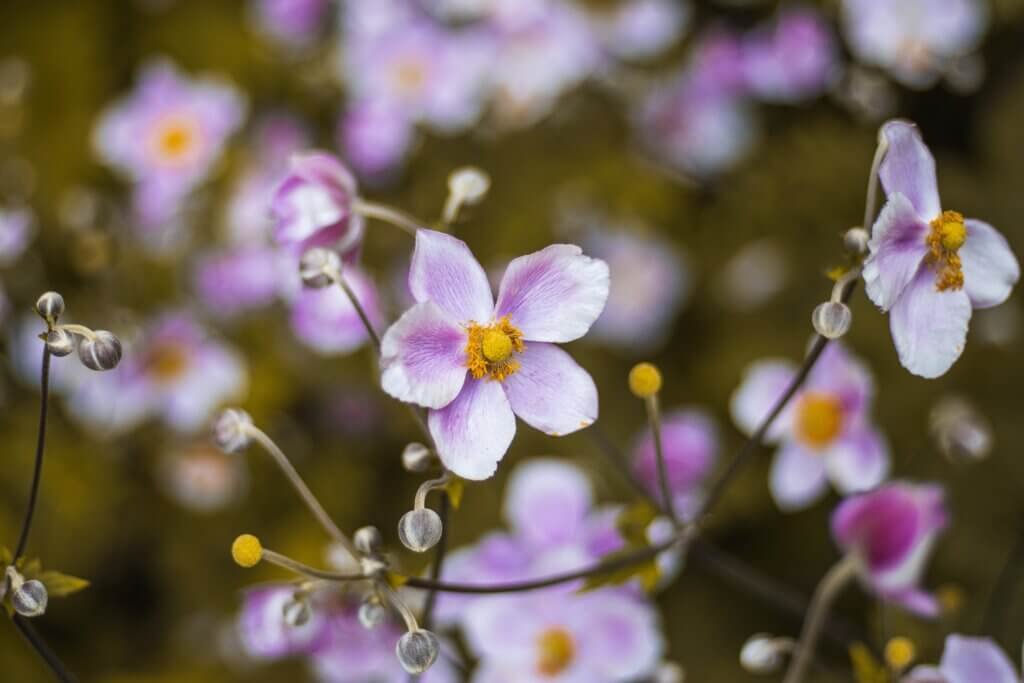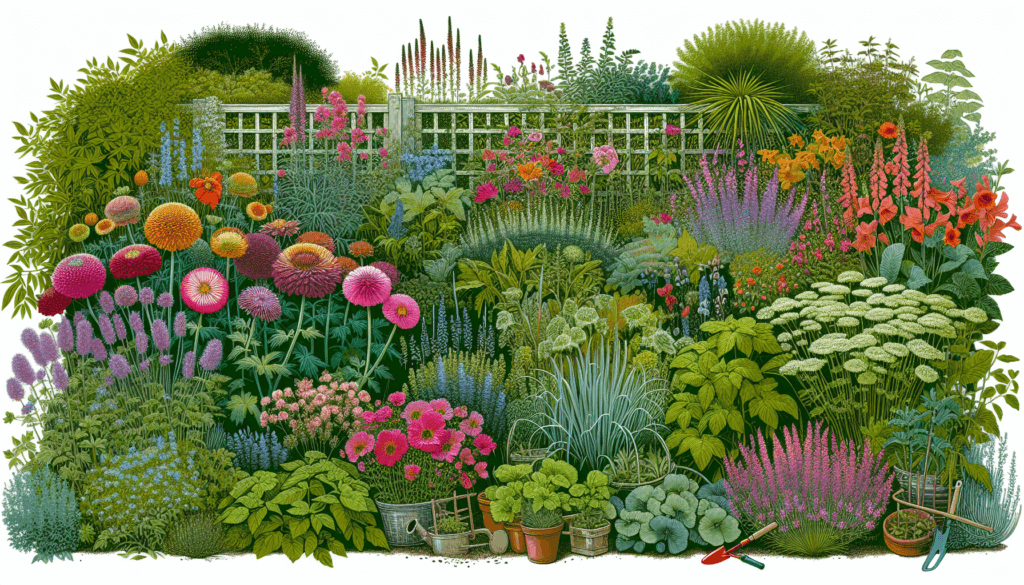If you’re looking to add some natural beauty and vibrant colors to your outdoor space, creating a herbaceous border garden might be just the project for you. With a wide variety of plants to choose from, you can easily create a stunning display that will have your neighbors green with envy. From selecting the perfect plants to arranging them in a visually pleasing way, this article will guide you through the most popular DIY projects for creating a herbaceous border garden that will transform your backyard into a paradise of blooming foliage.

Choosing the Right Location
When it comes to creating a herbaceous border garden, choosing the right location is crucial. You want to find an area in your yard that receives the optimal amount of sunlight and shade. Assessing sun and shade patterns throughout the day will help you determine the best spot for your garden. A good rule of thumb is to choose a location that gets at least six hours of sunlight per day, as most herbaceous plants thrive in sunny conditions.
In addition to sunlight, you also need to consider soil quality. Take the time to evaluate the soil in the potential location for your herbaceous border garden. Is it loose and well-drained, or is it heavy and compacted? Herbaceous plants generally prefer nutrient-rich, well-draining soil, so it is essential to choose a location with soil that can support these plants’ growth.
Lastly, evaluating the drainage of the area is vital. Poor drainage can lead to waterlogged soil, which can cause root rot and other issues for your herbaceous plants. Ensure that the location you choose has good natural drainage or take steps to improve the drainage by adding organic matter or creating drainage channels.
Designing the Border
Once you have chosen the right location for your herbaceous border garden, it is time to start planning the design of your border. One of the first considerations is determining the length and width of the border. Consider the available space and how much room you want to dedicate to your herbaceous border. A narrower border may be suitable for smaller gardens, while a wider border can create a more significant impact in larger yards.
When it comes to the shape of your border, you have the option to create either a curved or straight border. Curved borders can add a sense of flow and softness to your garden, while straight borders can provide a more formal, structured look. Consider the overall aesthetic of your yard and choose a border shape that complements the existing design.
Incorporating layers and heights is another element to think about in your design. By selecting plants of varying heights, you can create visual interest and depth in your herbaceous border. Taller plants can be placed towards the back, acting as a backdrop for smaller plants in the front. Additionally, layering plants with different textures and foliage can add dimension and diversity to your border.
Lastly, selecting complementary plants is essential for a cohesive and visually appealing herbaceous border. Consider the color palette you want to achieve and choose plants that complement each other in terms of color, texture, and bloom time. This will ensure that your border is a harmonious blend of plants that work well together.

Preparing the Soil
Before you start planting in your herbaceous border garden, it is crucial to prepare the soil properly. Clearing the area of any debris, such as rocks or weeds, is the first step. These can hinder plant growth and make it challenging to work in the area.
Next, removing weeds and grass is essential to prevent them from competing with your herbaceous plants for nutrients and water. Take the time to thoroughly remove any existing vegetation to give your plants the best chance at thriving.
Amending the soil is another crucial step in preparing your herbaceous border. Herbaceous plants generally prefer well-drained soil that is rich in organic matter. You can improve the soil by adding compost, well-rotted manure, or other organic materials to enhance its fertility and structure. This will provide the necessary nutrients for your plants to grow and flourish.
Improving drainage is particularly important if your soil tends to be heavy or clay-like. To improve drainage, you can incorporate organic matter into the soil, such as compost or well-rotted leaves. This will help loosen the soil and allow excess water to drain away more efficiently.
Lastly, testing the pH level of the soil is a good idea to ensure that it is within the appropriate range for herbaceous plants. Most prefer slightly acidic to neutral soil, with a pH range of 6.0 to 7.0. Testing kits are readily available and can help you determine if any adjustments need to be made to the soil pH.
Choosing the Right Plants
Choosing the right plants for your herbaceous border is essential for a successful and beautiful garden. One factor to consider is whether to include perennial or annual plants. Perennials come back year after year, providing long-term beauty to your border. On the other hand, annuals offer vibrant colors and continuous blooms throughout the season but need to be replanted each year.
Another consideration when selecting plants is their suitability for different seasons. By choosing plants that bloom at different times, you can ensure that your herbaceous border has color and interest throughout the year. Be mindful of the blooming seasons and choose plants that will provide a succession of blooms, from early spring to late fall.
In addition to considering bloom time, selecting plants with varied colors and textures is crucial for adding visual appeal to your herbaceous border. Mix plants with different leaf shapes, sizes, and colors to create a dynamic and interesting display. By incorporating a range of textures, from fine and delicate to bold and architectural, you can create a visually stunning garden.
Including both herbaceous and evergreen plants can also add interest and structure to your border. Herbaceous plants provide lush foliage and vibrant blooms, while evergreen plants offer year-round foliage and provide a backdrop for the changing seasons. The combination of these two types of plants can create a beautiful and visually appealing border.
Lastly, researching plant compatibility is vital to ensure that your chosen plants will thrive together. Some plants have specific requirements or preferences in terms of soil, sunlight, and moisture levels. By researching their individual needs, you can ensure that you create a harmonious and successful herbaceous border garden.

Planting Techniques
Once you have chosen the right plants for your herbaceous border, it is time to start planting. Arranging the plants in a nursery bed before transplanting them to the garden can help you visualize the design and make any necessary adjustments. This step also allows the plants to establish their root systems before being placed in their final positions.
Creating planting holes is crucial for ensuring that your plants have enough space and proper drainage. Dig the holes wider and slightly shallower than the root ball of the plant. This will allow the roots to spread out and establish themselves more efficiently.
When planting, it is essential to prune any damaged or circling roots and remove containers carefully. Gently loosen and spread out the roots to encourage healthy growth. Placing the plants at the appropriate spacing is also vital to avoid overcrowding and competition for resources. Follow the planting instructions specific to each plant to ensure proper spacing.
Establishing a Watering Routine
Watering is a vital aspect of maintaining a healthy herbaceous border garden, especially for newly planted plants. Watering new plants immediately after planting is crucial to help them establish and settle into their new environment. Give each plant a thorough watering, ensuring that the water reaches the root system.
Determining the frequency of watering is dependent on the weather conditions and the moisture needs of your plants. During hot and dry periods, you may need to water more frequently to prevent the soil from drying out. However, be cautious not to overwater, as this can lead to root rot and other issues.
Monitoring soil moisture is an essential part of establishing a watering routine. Check the soil regularly by inserting your finger into the soil to a depth of a few inches. If it feels dry, it’s time to water. If it feels moist, hold off on watering until the soil dries out a bit. Consistency is key when it comes to watering – aim to keep the soil evenly moist, but not waterlogged.
Using mulch is a great way to retain moisture in the soil and reduce water evaporation. Apply a layer of organic mulch, such as wood chips or shredded bark, around your plants. This will help regulate soil temperature, prevent weed growth, and conserve moisture, ensuring that your plants have a steady supply of water.

Maintaining the Border
To keep your herbaceous border garden looking its best, regular maintenance is essential. Regular watering and fertilizing will help nourish your plants and promote healthy growth. Follow the specific watering and fertilizing instructions for each plant to ensure optimal care.
Deadheading, or removing spent flowers, is an important maintenance task. This not only keeps your garden looking tidy and attractive but also encourages continuous blooming. Pruning is another maintenance task that helps manage the growth of your plants and keeps them in shape. Prune any damaged, diseased, or overgrown branches to maintain the overall health and appearance of your herbaceous border.
Dividing and transplanting plants is necessary to prevent overcrowding and rejuvenate older plants. Some herbaceous plants benefit from being divided every few years to maintain their vigor and promote new growth. By dividing and transplanting plants, you can also create new additions for your herbaceous border or share them with friends and neighbors.
Controlling weeds and pests is crucial to prevent them from overtaking your herbaceous border. Regularly inspect your plants for any signs of pests or diseases and take appropriate action if needed. Weed regularly to remove any unwanted plants that can compete with your herbaceous plants for nutrients and water.
Mulching and composting are additional maintenance tasks that can benefit your herbaceous border garden. Mulching not only conserves moisture but also helps suppress weed growth. Adding compost to your garden beds can improve soil fertility and structure, providing a nutrient boost to your plants.
Adding Decorative Elements
Adding decorative elements to your herbaceous border can enhance its beauty and create a personalized touch. Installing garden edging is one way to define the border and create a clean and polished look. There are various materials to choose from, such as stones, bricks, or metal, depending on the style and design of your garden.
Creating pathways or stepping stones can add functionality and visual interest to your herbaceous border garden. Use materials such as gravel, stone, or wood to create paths that lead visitors through your garden and allow easy access for maintenance tasks. Stepping stones can add a whimsical touch and serve as focal points within your garden.
Incorporating garden trellises or arches can provide vertical interest and support climbing plants. These structures can add height to your herbaceous border and create a striking visual impact. Choose trellises or arches that complement the style of your garden and select climbing plants that will thrive in the specific conditions.
Adding decorative planters or pots can provide versatility and flexibility in your herbaceous border garden. Place them strategically to create focal points or fill in gaps within your border. Choose pots or planters that complement the overall design and consider the size and shape of the plants you want to display.

Attracting Beneficial Insects
Creating a herbaceous border garden that attracts beneficial insects can contribute to a thriving and balanced ecosystem. Choosing plants that are known to attract pollinators, such as bees and butterflies, is an excellent way to ensure the health and productivity of your garden. Research specific plants that are bee and butterfly-friendly, and include them in your herbaceous border.
Providing shelter and water sources for beneficial insects is another essential aspect to consider. Incorporate features such as butterfly houses, bee hotels, or bird baths to create habitats for beneficial insects. These features can attract a variety of insects that play vital roles in pollination and pest control.
Avoiding the use of insecticides is crucial to protect the beneficial insects in your garden. Chemical insecticides can harm or kill not only the targeted pests but also the beneficial insects that help maintain a balanced ecosystem. Instead, practice natural pest control methods, such as handpicking pests or using organic insecticides when necessary.
Including butterfly and bee-friendly plants in your herbaceous border garden is a fantastic way to attract these beautiful and beneficial insects. Consider planting flowers with nectar-rich blooms, such as lavender, coneflower, or salvia, to provide a food source for butterflies and bees. By creating an inviting environment for these insects, you can enjoy their presence and contribute to their conservation.
Harvesting and Using Herbs
If you include herbs in your herbaceous border garden, harvesting and utilizing them is an enjoyable and rewarding experience. Identifying the right time for harvesting is essential to ensure the best flavor and quality of your herbs. Harvest herbs when they are at their peak, usually in the morning after the dew has dried but before the heat of the day.
Proper techniques for harvesting leaves and flowers will vary depending on the specific herb. In general, use clean, sharp scissors or pruners to cut stems just above a leaf node or a set of healthy leaves. This method encourages the plant to continue producing new growth.
After harvesting, drying and storing herbs is important to preserve their flavor and fragrance. Hang them upside down in a cool, dry, and well-ventilated area until they are fully dried. Once completely dry, store the herbs in airtight containers away from heat, light, and moisture.
Utilizing herbs in culinary and medicinal applications adds a delightful and beneficial dimension to your herbaceous border garden. Experiment with using fresh or dried herbs in cooking, such as adding them to soups, salads, or marinades. Many herbs also have medicinal properties, such as soothing chamomile or invigorating mint, which can be used in herbal teas or home remedies. Explore the multitude of ways to incorporate herbs into your daily life and enjoy the unique flavors and healing properties they offer.
Creating a herbaceous border garden is a wonderful DIY project that can bring beauty, fragrance, and functionality to your yard. By following these guidelines and considering each aspect of the process, you can design and create a stunning border that will be the envy of your neighborhood. Enjoy the journey of transforming your outdoor space into a vibrant and thriving herbaceous oasis!


